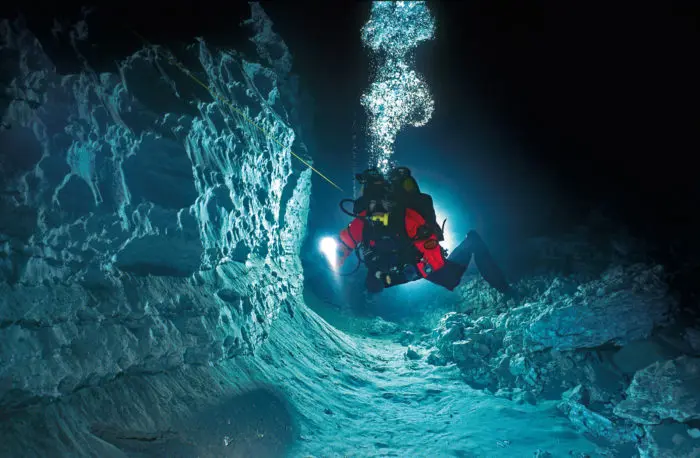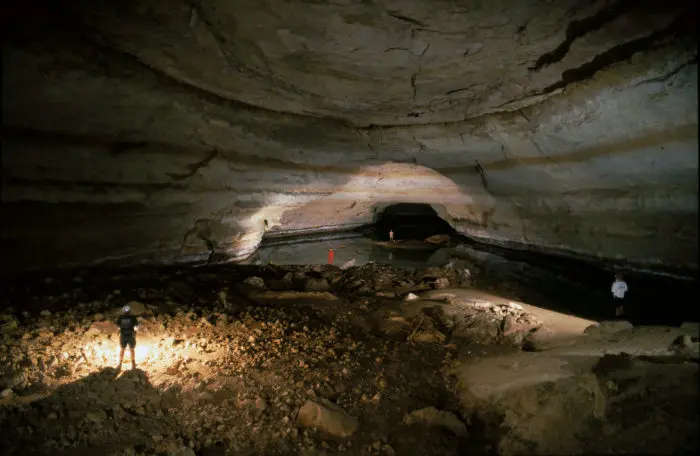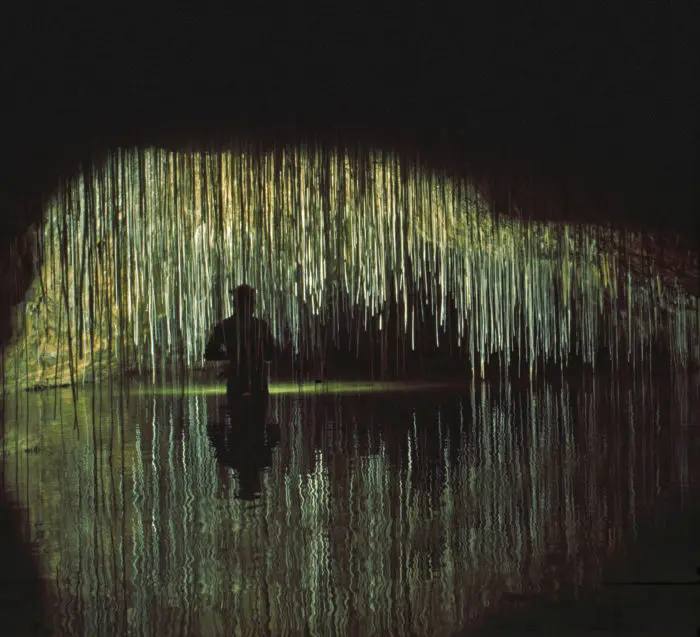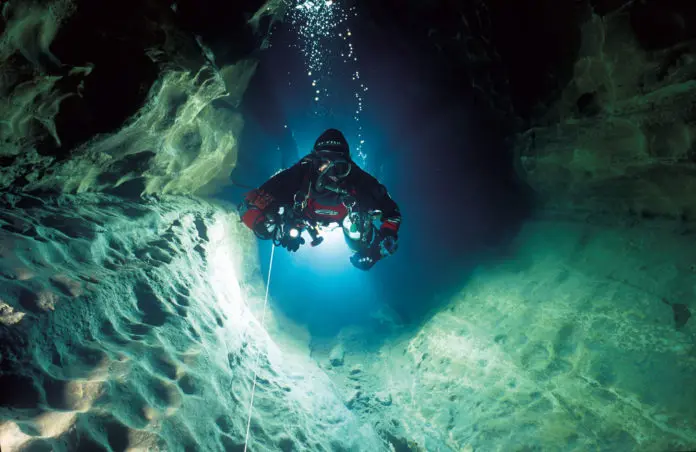In this exclusive excerpt from The Darkness Beckons, author Martyn Farr considers what the future might hold for cave diving.
Since The Darkness Beckons last appeared in 2000 there have been tremendous advances in the world of caving and diving. But the challenge presented to explorers today is no less than that confronting the early pioneers. To progress in this dark and potentially dangerous world contemporary activists will need to build upon the lessons of the past and, in doing so, become fully versed in every scientific, technological and human advance relevant to the project.

All facets of diving are steadily progressing. Equipment is constantly being developed and improved, as is training and supportive expertise. The advantages and disadvantages of the various breathing gases are better understood, and explorers are far better equipped to tackle their projects, which is reflected in the distances and depths that have been attained. With advances in caving technique, both long and deep dives are now being made at the end of some of the world’s most challenging and logistically difficult caves. Lightweight equipment has proved essential for such ventures, including the use of high-pressure, aluminium-fibreglass composite cylinders and easily portable rebreathers.
The sport has broadened its appeal greatly. Open-water divers are increasingly being drawn towards the challenges of cave and mine diving. This broader interest has led to greater commercialisation of equipment. Gear that was hitherto difficult and expensive to assemble is now often mass-produced. Thus the previously small world of cave diving has been broadened and strengthened. Information and advice is today disseminated by email and internet, and cheaper travel has also played its part.

The results? New cave systems will be explored, each with sumps to dive. Many of these will be far easier to vanquish than those that offered years of resistance in well-known caves. Fabulous new caving areas have been discovered in countries such as Vietnam and China. In 1984 and 1985 I was fortunate to have the opportunity to make the first dive in the impressive Clearwater Cave in Sarawak, Malaysia, and also at sites in southern China. (The Clearwater system is now one of the longest caves in the world with over 207 kilometres of dry passage known in 2014.)
The most exciting advances in the development of cave diving may be in longer and deeper dives. In Britain, in 1970, the longest dives were about 300 metres. By the end of the 1980s they were over 1,000 metres. In areas such as Florida, rebreathers, ‘staging’ and the use of DPVs have today taken a number of penetrations beyond 5,000 metres.
Depth, with its many associated limitations and dangers, is no longer the overruling deterrent that it once was. Jochen Hasenmayer and Sheck Exley pioneered the way in the 1980s, and today greater technical expertise, an endless array of computers and professional instruction is readily available. Lengthy decompression stops may constitute a high price to pay for a long, deep exploration, but, with careful forethought and planning, even the discomfort of this irksome experience can be lessened. Many divers have adopted electrical heating systems, and the use of habitats is now fairly common on deep diving projects.

At this point it is worth considering some of the deep ocean-diving approaches and equipment that might be employed to counteract the growing decompression problem. One possible tactic could be the adoption of a ‘one-atmosphere’ diving system. Here the diver is encased in a bulky crush-proof suit, with elaborate pressure joints to allow articulation while maintaining an internal pressure of one atmosphere throughout the dive. Several of these ‘tin-man’ suits have been used for commercial diving operations to depths of 700 metres. It is difficult to envisage these suits being adopted for cave exploration in the near future, but research is continuing.
Another possibility is the use of a miniature submarine. As a man well ahead of his time, Jochen Hasenmayer set a mark in the sand when he extended the Blautopf in Germany in just such a craft – Speleonaut – in 1990. We should not discount the possibilities. In the future it is entirely foreseeable that a miniaturised submarine could be able to ‘echo-locate’ and map its route on the inward journey to allow for an exit along precisely the same path.
Such ideas may seem futuristic, but as Dr Bill Stone has shown at Zacatón, and at Peacock Springs in 2016, this technology already exists, is advancing rapidly, and its application to cave diving is inevitable. This, in turn, will prompt another question: would greater reliance on sophisticated equipment mean a departure from the spirit of the sport? Even if it does, it is well to remember that sites such as Fontaine-de-Vaucluse and Wakulla Springs are few; the majority of explorations, while still highly dependent upon technological advance, will be conducted using conventional equipment.

No matter what equipment is utilised, project costs will inevitably escalate. The benefits of group organisation, with the sharing and maintenance of expensive apparatus, may well become a factor in the planning of expensive expeditions. To the individual diver focused on depth the expense will be significant. The price of helium, for example, increased by over 51 per cent between 2000 and 2011. It is clear that deep open-circuit operations using this gas will become even more expensive in the future and the use of rebreathers will be advantageous.
As ever, the pioneers will be few in number, and to mount some of their undertakings it is inevitable that financial support and sponsorship will be required. This will be accompanied by demands from publicity agents and the media. As a result, extra pressure may be placed on divers as they try to honour their commitments. It will be essential to take steps to manage these extra factors, and this may involve, for example, resisting pressure to dive at times when conditions or the diver’s psychological state are unfavourable.

Close on the heels of the pioneers, there will be many others keen to emulate and enjoy for themselves the wonders of such a unique and remote environment. This tendency is already apparent. Sump 1 in the Émergence du Ressel in France has already become a ‘badge of achievement’ in the technical diving community.
International cooperation and exchange of ideas have also aided the development of the sport. The British have a long track record of expertise in restricted environments and low visibility; the Americans, French and Swiss were long the masters of lengthy and deep penetrations. Since 2000 these broad distinctions have been blurred as exchange of information has become ever more rapid.
Despite this progress the inherent dangers of activity underground remain unchanged. Completely autonomous deep-diving penetrations are edging towards the limits of human endeavour and there is little doubt that the risks involved leave the diver extremely vulnerable. It seems that even with modern technology and knowledge that many early pioneering dives could not be repeated, even by the pioneers themselves, with any degree of safety assured.
But training and safety education are growing. No one would dispute the benefit of diver training in the past thirty years. The days of ignorance and horrific statistics are now in the past. However, there is no room for complacency. Serving to bring this home was the 2012 tragedy in a sea cave at Palinuro, near Naples in Italy. A large group of divers was being led into Grotta degli Occhi (Cave of the Eyes). Somehow the party split and a number of the tour group swam into a muddy side tunnel. In the ensuing silt-out four of them drowned – less than 40 metres from the entrance and at a depth less than 14 metres.
Whatever type of projects you may be contemplating, my plea is a simple one: consider carefully your motives, aims and objectives, and pursue them with circumspection and humility, ever mindful that this is a potentially lethal activity.
Cave diving will always be an objectively dangerous sport, but providing it is approached in a mature, responsible manner, it will remain one of the most exciting pioneering sports of our times, with immense potential for development. Future prospects can be equally as exciting as those of the past. New exploration may be hard won, but there will always be determined individuals prepared to accept the challenge.
You can buy the revised edition of The Darken Beckons via the publisher here.

